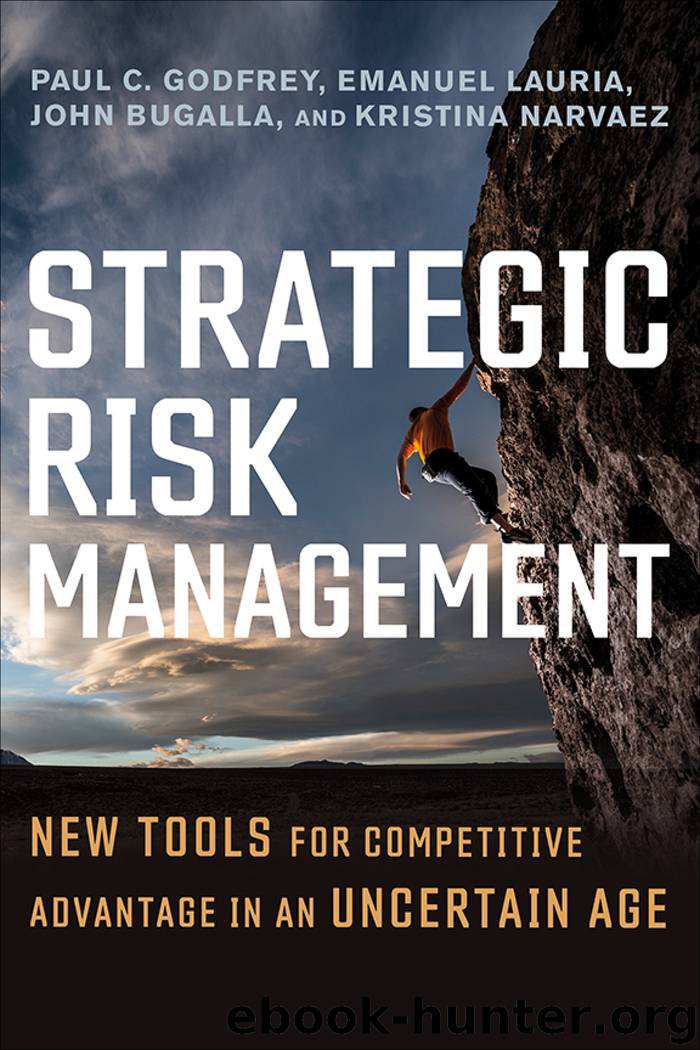Strategic Risk Management by Paul C. Godfrey

Author:Paul C. Godfrey
Language: eng
Format: epub
Publisher: Berrett-Koehler Publishers
Published: 2020-03-20T16:00:00+00:00
STEP 3: LABEL THE AXES AND CREATE THE SCENARIOS
Each axis represents a continuum, and, consistent with the goals of scenario planning, the endpoints need to capture extreme potential outcomes. Scenario builders should avoid bland-sounding labels such as pessimistic, optimistic, more, or less and instead use graphic descriptions like Mariana Trench or Moonshot. End points define the peaks of what’s ultimately possible, not the muddy valleys of the currently probable. Being outlandish here is a virtue, because expansive boundaries leave plenty of room for imaginative thinking. Catchy and provocative labels resist uncertainty absorption and the dominance of midrange thinking.
Scenario cartographers draw their maps by placing the uncertainty continua perpendicular to and bisecting each other. This arrangement creates four quadrants corresponding to the available combinations of the critical uncertainties. One quadrant will be “low-low” and one “high-high,” based on the ends of each continuum. These two represent opposite worlds, an interesting diagonal that lends itself to consistent responses. Low-low typically represents an extension of the status quo, as uncertainties resolve in ways little different from current arrangements. While it is attractive to market incumbents because it features little need for new investment, the low-low outcome has a low prima facie probability of 25%.
If the low-low quadrant favors current competitors, then the high-high future opens opportunities for new entry, through either entrepreneurial startups or corporate diversification, by firms with the resources and capabilities to perform the job to be done in a radically different future. High-high, like its opposite, has a 25% chance of coming to fruition.
The off-diagonal quadrants foreshadow complex futures, ones without the clarity of little or radical change. These quadrants contain high-low blends, and decision makers need to attend to the nuances of each configuration in terms of market sizes, segments, production possibilities, and regulatory regimes. A blended, complex world represents the most likely outcome, with a 50% probability of some high-low combination.
The next task involves naming each scenario. Good scenarios employ provocative titles that emphasize the potential inherent in each one. Again, the goal is to create extreme cases that move normally staid strategic planners to view the future differently. Catchy sound bites work best, and richly descriptive words like heaven and hell, paradise and purgatory, invite decision makers to push the boundaries of their own thinking about what’s possible. The final element of the map is a rich picture of each scenario that describes a discrete future in terms of elements of interest, such as product categories, cost drivers, or the nature and shape of consumer demand.
Figure 6.2 presents a simple scenario map for mobile computing, as it might have looked in 1996 and 1997. Our logic suggested that we frame the future in terms of how customers would use a mobile device (as a substitute or complement to a desktop machine) and of the ubiquity of connectivity, based on final consumer cost. Different futures are laid out in the four scenarios, and our map would have provided Intel planners with a high-level take on two product categories: large desktop machines (then the dominant form of computing) and small mobile devices.
Download
This site does not store any files on its server. We only index and link to content provided by other sites. Please contact the content providers to delete copyright contents if any and email us, we'll remove relevant links or contents immediately.
Hit Refresh by Satya Nadella(8325)
The Compound Effect by Darren Hardy(7540)
Change Your Questions, Change Your Life by Marilee Adams(6632)
Nudge - Improving Decisions about Health, Wealth, and Happiness by Thaler Sunstein(6626)
The Black Swan by Nassim Nicholas Taleb(6178)
Daring Greatly by Brene Brown(5632)
Deep Work by Cal Newport(5446)
Principles: Life and Work by Ray Dalio(5312)
Rich Dad Poor Dad by Robert T. Kiyosaki(5137)
The Myth of the Strong Leader by Archie Brown(4782)
Man-made Catastrophes and Risk Information Concealment by Dmitry Chernov & Didier Sornette(4723)
Big Magic: Creative Living Beyond Fear by Elizabeth Gilbert(4712)
The Slight Edge by Jeff Olson(4711)
Discipline Equals Freedom by Jocko Willink(4626)
The Motivation Myth by Jeff Haden(4518)
Digital Minimalism by Cal Newport;(4501)
Stone's Rules by Roger Stone(4409)
Management Strategies for the Cloud Revolution: How Cloud Computing Is Transforming Business and Why You Can't Afford to Be Left Behind by Charles Babcock(4125)
The Doodle Revolution by Sunni Brown(4031)
